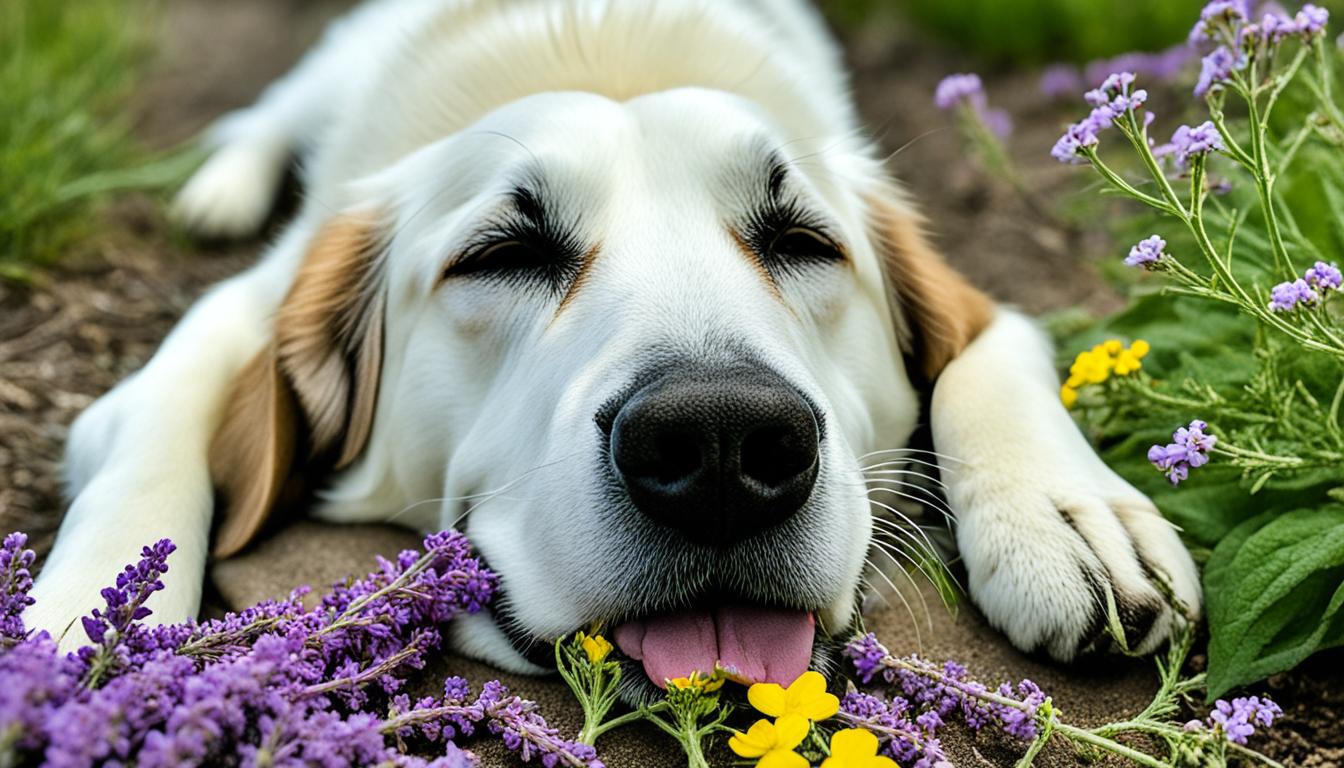Understanding Dog Aggression
Dog aggression is a complex behavioral issue that requires careful attention and understanding from pet owners. By recognizing the manifestations and understanding the different types of aggressive behavior, pet owners can take appropriate steps to address and manage their dog’s aggression.
Manifestations of Dog Aggression
Aggression in dogs can manifest in various ways, which should alert pet parents to take action promptly to avoid escalation. Some common manifestations of dog aggression include:
- Growling: Dogs may growl as a warning sign to communicate their discomfort or aggression.
- Lunging: Dogs may lunge forward aggressively, attempting to reach or attack a person or another animal.
- Loud Barks: Intense and persistent barking can be a sign of aggression, especially when accompanied by other aggressive behaviors.
- Nips or Bites: Dogs may use their teeth to assert dominance or defend themselves when feeling threatened.
However, it’s important to note that aggression does not always escalate to physical harm. Early signs of aggression can include yawning, blinking, nose-licking, turning the head or body away, stiffening up, staring, growling, snapping, and biting (ManyPets). Recognizing these signs early on can help pet owners intervene before the situation worsens.
Types of Aggressive Behavior
Dog aggression can stem from various factors and can be classified into different types based on its underlying cause. Here are some common types of aggressive behavior in dogs:
- Territorial Aggression: Dogs may display aggression when they feel their territory is being invaded or threatened.
- Possessive Aggression: Dogs may become aggressive when they perceive a threat to their resources, such as food, toys, or attention.
- Maternal or Protective Aggression: Female dogs may exhibit aggression to protect their puppies or their owners.
- Pain-Related or Irritable Aggression: Dogs in pain or discomfort may display aggression as a defensive response.
- Predatory Aggression: Dogs with a strong prey drive may display aggressive behavior when pursuing or attempting to catch smaller animals.
- Frustration or Redirected Aggression: Dogs may redirect their aggression toward an unrelated target when they are frustrated or unable to reach their intended target.
- Social Conflict-Related Aggression: Dogs may show aggression during social interactions with other dogs or unfamiliar individuals.
- Sexual Aggression: Intact male dogs may exhibit aggression toward other male dogs or display dominant behavior.
- Disease-Related Aggression: Certain medical conditions can contribute to changes in behavior, including aggression.
- Fear- or Anxiety-Related Aggression: Dogs may display aggression as a response to fear or anxiety-provoking situations.
Understanding the different types of aggressive behavior can help pet owners identify the underlying causes and develop appropriate training and management strategies.
By recognizing the manifestations and understanding the types of aggressive behavior in dogs, pet owners can seek the necessary guidance and professional intervention to address their dog’s aggression effectively. In the following sections, we will explore training techniques, management strategies, and professional interventions for dealing with dog aggression.
Causes of Dog Aggression
Understanding the causes of dog aggression is crucial for addressing and managing this behavior effectively. Aggression in dogs can arise from various factors, including trauma and underlying health issues. Recognizing the warning signs is essential for early intervention and training.
Trauma and Aggression
Traumatic experiences, especially in rescue dogs, can significantly contribute to aggressive behavior. Dogs that have experienced abuse, neglect, or other traumatic events may display fear-based aggression as a defense mechanism to protect themselves from perceived threats (Ancillary K9). It’s important to approach these dogs with patience, understanding, and positive reinforcement training to help them overcome their past experiences and build trust.
Recognizing Warning Signs
Recognizing the warning signs of aggression is crucial for pet owners to address potential issues promptly. While aggression can manifest in various ways, common warning signs may include:
- Growling or snarling
- Baring teeth
- Lunging or charging
- Biting or snapping
- Stiff body posture
- Raised hackles (the hair on the dog’s back)
- Intense staring
- Raised tail or tail tucked between legs
- Excessive barking or vocalization
It’s important to note that aggression in dogs can be a normal form of communication, but aggression towards a person or animal is often considered undesirable or problematic. Most canine aggression is affective or emotionally motivated, often stemming from fear and anxiety (VCA Canada). Understanding the underlying emotions behind the aggression can help in developing effective training and management strategies.
If you notice any signs of aggression in your dog, it is recommended to seek guidance from a professional dog trainer or certified behavioral consultant. They can assess the situation, identify the root causes, and provide appropriate training techniques to address and modify the aggressive behavior. Remember, early intervention is key to preventing the escalation of aggression and ensuring the safety and well-being of both your dog and others.
In addition to trauma, other factors such as pain, anxiety, boredom, pregnancy, neurological problems, and even rabies can contribute to aggressive behavior in dogs (Veterinary Emergency Group). If your dog displays sudden changes in behavior or aggression, especially if accompanied by other concerning symptoms, it is essential to consult a veterinarian to rule out any underlying health issues.
By understanding the causes of dog aggression and being vigilant for warning signs, pet owners can take proactive steps to address and manage aggressive behavior through proper training, behavior modification techniques, and, if necessary, professional intervention.
Training Techniques for Aggressive Dogs
When dealing with dog training for aggressive dogs, it’s essential to approach the process with caution and employ effective training techniques. Two commonly used methods for training aggressive dogs are socialization methods and positive reinforcement training.
Socialization Methods
Socialization plays a crucial role in helping aggressive dogs overcome their behavioral issues. Effective socialization techniques include:
-
Habituation: Gradual exposure to various stimuli in a controlled manner to help the dog become accustomed to new environments, objects, and people.
-
Counterconditioning: Pairing the presence of a trigger that usually elicits aggression with positive experiences, such as treats or playtime, to change the dog’s emotional response.
-
Conditioning and Desensitization: Gradually exposing the dog to the trigger that causes aggression at a low intensity, rewarding calm behavior, and progressively increasing the exposure over time.
-
Positive Reinforcement: Rewarding the dog for displaying positive behaviors, such as calmness or appropriate social interactions, to encourage desired behavior around other dogs.
-
Second-Order Reinforcement: Incorporating a secondary reinforcer, such as a clicker or whistle, to signal the dog when they perform a desired behavior. This helps reinforce the behavior for future displays.
It’s important to note that socializing an aggressive dog should be done under the guidance of a professional dog trainer or behavioral consultant. They can develop a behavior modification program tailored to the specific needs of the dog, ensuring safety and positive progress. For more information on professional intervention, refer to the section on seeking certified behavioral consultants.
Positive Reinforcement Training
Positive reinforcement training is widely used by professional dog trainers to address aggression and encourage calm behavior in dogs. This method focuses on rewarding the dog for displaying desirable behaviors rather than punishing or scolding for unwanted behaviors.
The key principles of positive reinforcement training for aggressive dogs include:
-
Rewarding Calm Behavior: When the dog exhibits calm behavior, such as sitting or staying relaxed around other dogs, they are rewarded with treats, praise, or playtime. This helps reinforce the association between calmness and positive outcomes.
-
Clicker Training: Utilizing a clicker, a small handheld device that produces a distinct sound, to mark the exact moment the dog displays the desired behavior. This helps the dog understand which behavior is being rewarded.
-
Consistency: Consistently rewarding the dog for positive behavior and withholding rewards for unwanted behavior helps the dog understand the expectations and encourages them to repeat the desired behaviors.
-
Patience and Persistence: Training an aggressive dog can be a lengthy process, requiring patience and persistence. Consistently practicing positive reinforcement techniques and gradually increasing the difficulty of training exercises can yield positive results over time.
Positive reinforcement training can be effective in redirecting aggressive behavior and promoting better social interactions. However, it’s essential to work with a professional dog trainer experienced in dealing with aggression to ensure the safety of both the dog and those around them.
In addition to training techniques, managing aggressive behavior in dogs involves providing adequate exercise and mental stimulation to reduce stress and anxiety. Dogs with high exercise needs, such as those in the terrier, herding, working, sporting, and scenthound groups, typically require 60-120 minutes of exercise per day. Indoor stimulation through play, interactive games, puzzle toys, and chew toys can also contribute to reducing aggressive tendencies in dogs.
By employing socialization methods and positive reinforcement training, pet owners can work towards transforming aggressive behavior in their dogs and creating a harmonious environment for both the dog and their human companions. Remember to seek professional guidance and practice patience throughout the training process to ensure the best possible outcome.
Managing Aggressive Behavior
When dealing with aggressive behavior in dogs, effective management strategies are essential for the safety and well-being of both the dog and those around them. Two key aspects of managing aggression include providing adequate exercise and stimulation, as well as identifying triggers that can lead to aggressive outbursts.
Exercise and Stimulation
Providing enough exercise and mental stimulation is vital in managing dog aggression. Regular physical activity helps to release pent-up energy and can reduce frustration and aggression. The exercise needs of dogs vary depending on their breed, size, and energy level. For example, dogs in the terrier, herding, working, sporting, and scenthound groups typically require 60-120 minutes of exercise per day (ManyPets).
Engaging in activities such as walking, jogging, playing fetch, or participating in agility training can help redirect the dog’s energy in a positive manner. Additionally, indoor stimulation through interactive games, puzzle toys, and chew toys can provide mental enrichment and contribute to reducing aggressive tendencies.
Identifying Triggers
One crucial aspect of managing aggressive behavior is identifying triggers that can lead to aggressive outbursts in dogs. Common triggers include encounters with other dogs, loud noises, unfamiliar humans, and objects with wheels. Understanding these triggers can help pet owners avoid situations that may provoke aggression in their dogs.
By recognizing the specific triggers, pet parents can work on desensitization and counterconditioning techniques with the guidance of a certified behavioral consultant. These techniques involve gradually exposing the dog to the trigger in a controlled and positive manner, helping them develop a more positive association and reducing their aggressive response. For example, if a dog displays aggression towards unfamiliar humans, controlled interactions with trusted individuals can be gradually introduced under controlled circumstances to promote positive experiences and reduce fear or aggression.
It’s important to note that aggression can also be a sign of underlying pain or discomfort in dogs. If a dog displays aggression seemingly out of the blue, it is crucial to seek veterinary care to rule out any physical health issues that may be causing pain or discomfort (Veterinary Emergency Group).
By ensuring adequate exercise and mental stimulation while also identifying and managing triggers, pet owners can take significant steps in managing aggressive behavior in their dogs. However, for more severe cases of aggression, seeking professional intervention from certified behavioral consultants and considering behavior modification techniques or medication may be necessary.
Professional Intervention
When dealing with dog aggression, seeking professional intervention can be an essential step in addressing and managing the problem effectively. Certified behavioral consultants and medication with behavior modification are two key aspects of professional intervention.
Seeking Certified Behavioral Consultants
Certified behavioral consultants are professionals with expertise in dog behavior and training. They possess the knowledge and experience to assess the underlying causes of aggression and develop a comprehensive behavior modification plan. These consultants can provide guidance and support tailored to the specific needs of your dog.
Working with a certified behavioral consultant involves a thorough evaluation of your dog’s behavior, including their triggers and reactions. They will help you understand the root causes of aggression and design a training program to address those issues. Techniques such as habituation, counterconditioning, conditioning and desensitization, and positive reinforcement are often employed to modify aggressive behavior (Alpha Paws).
Through personalized guidance and training, certified behavioral consultants can help you develop the skills and strategies necessary to manage your dog’s aggression. They can also provide ongoing support and adjustments to the training plan as needed.
Medication and Behavior Modification
In some cases, medication may be recommended as part of the treatment plan for aggressive dogs. Medications can help manage the underlying causes of aggression, such as anxiety or fear, and assist in behavior modification. However, it’s important to note that medication alone is not a cure for aggression.
The use of medication is typically combined with behavioral and environmental modifications. The goal is to reduce the frequency and intensity of aggressive behavior, although complete elimination of aggression may not be possible (VCA Canada). The specific medication and dosage will be determined by a veterinarian or veterinary behaviorist based on your dog’s individual needs.
Behavior modification techniques, such as desensitization and counterconditioning, are often incorporated into the treatment plan alongside medication. These techniques involve gradually exposing your dog to their triggers in a controlled and positive manner to change their emotional response (VCA Canada). It’s important to work closely with a certified professional to ensure the safe and effective implementation of medication and behavior modification techniques.
By seeking professional intervention, you can access the expertise and guidance necessary to address your dog’s aggression in a safe and effective manner. Remember to follow the safety guidelines provided by professionals, such as physical separation when supervision is unavailable and using appropriate restraints like leashes or muzzles when necessary (VCA Canada). With the right support and treatment, aggressive behavior in dogs can be managed and improved, leading to a safer and more harmonious relationship with your furry friend.
Safety Measures and Prevention
When dealing with aggressive dogs, it is essential to prioritize safety measures and prevention strategies to ensure the well-being of both the dog and those around them. Punishment-based training techniques should be avoided, as they can escalate aggression and potentially worsen the situation. Instead, positive reinforcement training is recommended to encourage desired behavior (VCA Canada).
Avoiding Punishment
Studies show that confrontational and punishment-based training techniques, such as using physical aversive devices like prong collars and shock collars, are associated with increased aggressive behavior in dogs. Verbal reprimands should also be avoided, as they can further escalate aggression (VCA Canada). Instead, positive reinforcement training methods should be employed, focusing on rewarding desired behavior with treats, praise, and playtime. This approach promotes a positive and trusting relationship between the dog and their owner, leading to more effective and long-lasting results.
Safety Guidelines for Aggressive Dogs
When dealing with an aggressive dog, it is crucial to implement safety guidelines to prevent any potential harm. The following safety measures should be considered:
-
Physical Separation: If an adult is unavailable to supervise, it is recommended to physically separate the aggressive dog from other dogs or pets in the home. This can be achieved by using baby gates or keeping the dogs in separate rooms.
-
Leash Restraint: When in public or around other animals, an aggressive dog should be restrained on a leash to prevent any lunging or aggressive behavior. Using a sturdy leash and a well-fitted harness can provide better control and minimize the risk of incidents.
-
Head Halter: For additional control over an aggressive dog, a head halter can be used. This tool can help redirect the dog’s attention and prevent them from pulling or reacting aggressively.
-
Basket Muzzle: In some cases, a basket muzzle might be recommended to ensure the safety of other animals or people. Muzzles should be properly fitted and comfortable for the dog to wear.
It is important to consult with a professional dog trainer or a certified behavioral consultant to develop a tailored plan for managing aggression and implementing safety guidelines specific to the dog’s behavior and needs.
By avoiding punishment-based training methods, prioritizing positive reinforcement, and following safety guidelines, pet owners can create a safer environment for both their aggressive dogs and those who interact with them. Remember, seeking professional intervention and guidance is crucial in addressing and managing dog aggression effectively.






